#hoodoo in New England
Explore tagged Tumblr posts
Text

✨18th Century Nkisi bundle found in Newport, Rhode Island
🌿Hi everyone! I wanted to share with you all this article of a historical example of African religion and spirituality in colonial New England. This is a 1700s religious Nkisi bundle more than likely owned by an enslaved African man named CARDADO WANTON who was trafficked to New England in the 18th century.
“A Nkisi Bundle Was Found in a Historic Newport Home - But What Is It, Exactly?”
💙 “In 2005, representatives of the Newport Historical Society working on the Wanton-Lyman-Hazard House found a bundle of items concealed beneath an attic floorboard.”
“The items, known collectively as an nkisi bundle, were likely owned by Cardardo Wanton and held spiritual significance for their owner, a man enslaved by the Wanton family in the late eighteenth century.”
“Nkisi (and its plural, minkisi) comes from a Bantu word loosely meaning ‘to take care’ and often includes buttons, nails, cowrie shells and other household items. They take the form of figures or bundles and played a role in connecting enslaved people of African descent with their ancestors. ‘It reminded them of their humanity in a world that told them constantly and consistently that they were not human,’ de Barros Gomes says.”
This along with other items are on display until 2026 as part of the “Entwined: Freedom, Sovereignty and the Sea,” at the Mystic Seaport Museum in Mystic, Connecticut.
“Entwined: Freedom, Sovereignty and the Sea” is a major maritime exhibition centering maritime histories of Indigenous, African, and African-descended worldviews and experiences in New England.
#hoodoo#rootwork#afrowitch#conjure#historical resources#New England hoodoo#cardado wanton#hoodoo in New England#slavery#colonial New England#nkisi#minkisi#Black witch#3#espiritismo
7 notes
·
View notes
Note
Hi, weird question maybe, I'm just some guy who stumbled on your quora answers and figured you're pretty knowledgeable. I'm Italian and I'm wondering if you knew of any forms of magic that could be compared to what in Italy is referred to as 'low ceremonial magic', usually practiced by farmers / poor people. I'm looking for similar traditions in other parts of the world because I'm trying to figure out what kind of magic is most practiced by low income people historically. Thanks a lot
Great question! I'm still in the process of learning about "low magic" or "folk magic." I usually call it folk magic, to distinguish it from ceremonial magic, although the lines between the two are pretty thin and there's significant overlap. (The difference seems to be mainly a class distinction.) If you want to research it, I recommend using "folk magic" as your keyword.
My own country, the United States, has several robust traditions of folk magic that tend to go unnoticed by people who aren't in contact with them. Appalachian Magic is one of the big ones, and Southern Conjure is another one of the big ones. New England has its own variant of English "cunning." Hoodoo and Rootwork are both African diasporic traditions, based in Vodou and practiced mainly in the South. There's also "Pow-Wow," which is mainly Pensylvannia Dutch, Curanderismo and Brujeria (Hispanic), various magical traditions that stem from indigenous religions, and the extremely popular New Age variant of folk magic (which is apparently called "manifesting"). I'm not intimately familiar with all of these systems, but I highly recommend reading New World Witchery by Cory Thomas Hutcheson for a primer on North American folk magic.
The one I know the most about is English "cunning." I just did a project for which I translated part of Bald's Leechbook, a medieval book of herbal remedies written in Old English that was intermixed with some folk spells. I've observed that folk magic tends to be very Catholic, or Catholic-syncretic, because Catholicism has a lot of folk-magic stuff built right into it (like saints' medallions and votive offerings) that were intentionally rooted out of Protestantism. But hey, new folk traditions are always popping up all the time. Tarot cards are only about two hundred years old, but they're a valid and effective divination method, and you can find them in any mainstream bookstore these days.
Finally, I feel the need to say that folk magic is very dark. There's a common idea, mainly in New Age and neopagan circles, that your spells will rebound on you if they're unethical. This has no historical grounding. Curses, forceful love spells, bindings, and other baneful spells are really common. Frequently, magic was the only source of power or agency for people with no other options. Sanitizing folk magic does it a disservice. That doesn't mean that you have to practice baneful magic, only that you should understand why it exists and respect it.
#folk magic#folk witchcraft#witchblr#witchcraft#history of magic#occultism#occult#folklore#folk spellcraft
21 notes
·
View notes
Text
From @publicdomainreview ~ Born in Five Points, Manhattan to a Black mother and a white father who left soon after his birth, Paschal Beverly Randolph (1825–1875) grew up in poverty that deepened after his mother died of cholera when he was six. After a difficult, itinerant childhood, he recounts working on ships sailing between New England, Cuba, and Britain, before beginning to lecture on spiritualism and perform as a trance medium. In 1858, however, he publicly broke with the spiritualists, citing their racism, the hypocrisy of their radicalism, and their narrow view of the immaterial world. In a series of lectures, he attacked the characters of leading spiritualists, ridiculed their trances as “jugglery” (or worse, demon possession), dismissed their “business of world-bettering” as hypocrisy, and railed against some of their central tenets, such as the belief popularized by Andrew Jackson Davis that only select souls are immortal and thus all spirits are good. He concludes, “My crime was rete mucosmal”, residing in the color of his skin. Randolph relates that after a harrowing suicide attempt (or, as he explained it elsewhere, a transformative experience with Egyptian hashish), he finally left spiritualism behind. While Western occultists balked at a “tawny student of Esoterics” like Randolph, they often invested their knowledge with power by racializing it, attributing its secrets to Oriental, Chaldaic, Persian, Egyptian, Asiatic, or Arab sources. Randolph trafficked in this manufactured exoticism too, but also developed a philosophically and politically complicated theory of the occult anchored in his own racialized identity. “I owe my successes,—mental,—to my conglomerate blood; my troubles and poverty to the same source”. He spent two of his most productive writing years in Louisiana, where he encountered the area’s rich African diasporic religious life. Although in one of his lectures he boasts of exposing “the whole tribe of voudeaux in New Orleans”, he also concedes “it was from one of the voudeaux queens . . . that I gained much of my knowledge”, and elsewhere he cites hoodoo and obeah practices and flaunts the secrets he learned from “the quadroons of Louisiana”. His self-identification as a “sang mêlée” — Randolph’s curiously feminized form of the colonial intellectual Moreau de Saint-Méry’s term for people with the smallest fraction of African ancestry — afforded him “peculiar mental power and almost marvelous versatility”. Because he already channeled multiple racial identities within his body, Randolph reasoned, he was predisposed to channel other identities, not of this world. [More at link.]
30 notes
·
View notes
Text
An Exhaustive List of Witch Movies
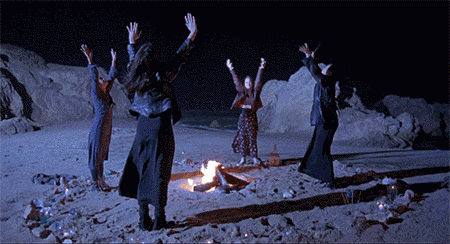
Witches/witchcraft comes in all shapes and forms. Below are lists of different iterations within the horror genre.
Period Pieces: Witch Hysteria of the 17th Century

The Witchfinder General (1968) — England; 1645
Blood on Satan’s Paw (1971) — England; 1700
The VVitch (2019) — New England; 1630
The Cleansing (2019) — Wales; 1550
The Reckoning (2020) — Northern England; 1665
A Coven of Sisters (2021) — Spain; 160
The Baba Yaga

The Baba Yaga (1973)
Wicked (2013)
Don’t Knock Twice (2016)
The Wretched (2019)
Gretel and Hansel (2020)
Baba Yaga: Terror of the Dark Forest (2021)
Witchcraft Gone Wrong
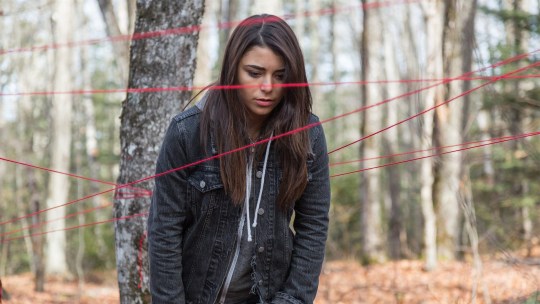
Halloween 3: Season of the Witch (1982)
The Craft (1996)
The Witchouse (1999)
Jennifer’s Body (2009)
Pywacket (2018) Bad Witch (2021)
The Family Legacy
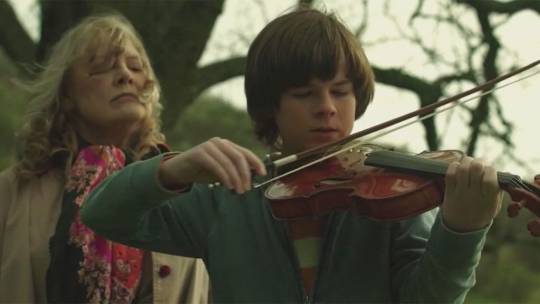
The Covenant (2006)
Mercy (2014)
Hereditary (2018)
The Influence (2019)
Binding (2020)
Voodoo / Hoodoo

Angel Heart (1987)
The Serpent and the Rainbow (1988)
The Skeleton Key (2005)
Jessabelle (2014)
Spell (2020)
Zombi Child (2020)
Found Footage

The Blair Witch Project (1999)
They’re Watching (2016)
Blair Witch (2016)
The Last Witch (2017)
Curse of the Dead Witch

The Devonsville Terror (1983)
Blair Witch 2: Book of Shadows (2000)
Drag Me to Hell (2009)
The Conjuring (2013)
The Witching (2014)
House of the Witch (2017)
The Witch in the Window (2018)
The Unholy (2021)
Dario Argento’s Three Mothers Trilogy
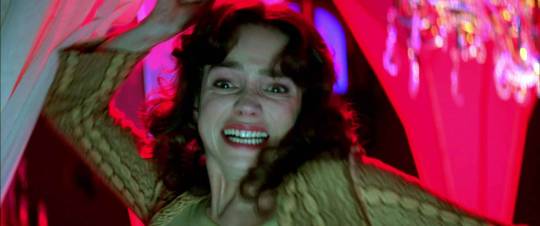
Suspiria (1977)
Inferno (1980)
Mother of Tears (2007)
Arthouse Horror

Black Sunday (1960)
Lords of Salem (2012)
Neon Demon (2016)
Suspiria (2018)
Other Witchy Movies just for fun
#HailSatan
Rosemary’s Baby (1968)
Witchcraft (1988)
The House of the Devil (2009)
The Blackcoat’s Daughter (2015)
The Devil’s Candy (2015)
Satanic (2016)
Ready or Not (2019)
Satanic Panic (2019)
The Conjuring 3: The Devil Made Me Do It (2021)
Pagan Cults
Kill List (1971)
Wicker Man (1973)
Wake Wood (2011)
Starry Eyes (2014)
Ritual (2017)
Apostle (2018)
Midsommar (2019)
Genre-Bending Witches
Autopsy of Jane Doe (2016)
Wicked Witches (2019)
We Summon the Darkness (2020)
His House (2020)
Family Fun
The Wizard of Oz (1939)
The Witches of Eastwick (1987)
Practical Magic (1989)
The Witches (1990)
Hocus Pocus (1993)
Eve’s Bayou (1997)
Season of the Witch (2011)
Into the Woods (2014)
Maleficent (2014)
The Witches (2020)
#horror films#horror film#witches#witchyvibes#witch#we watch scary movies#horror movies#horror movie#witchcraft
279 notes
·
View notes
Text
Black History Month Public Domain Reading List
I’d seen a list floating around the internet with links to pirated books by black writers of note for black history month. I felt that it was problematic to be sharing something that’s disenfranchising black writers when there are a lot of great books by black writers to read that are in the public domain and free to read. I compiled this list of books by various black writers of note with descriptions and links to a site to download them onto your devices. The site is Project Gutenberg, the original e-book site, releasing ebooks since, surprisingly, 1971.
Slave Narratives & Other Writings
Up from Slavery: An Autobiography by Booker T. Washington (A Memoir). This is his personal experience of having to work to rise up from the position of a slave child during the Civil War, to the difficulties and obstacles he overcame to get an education at the new Hampton Institute, to his work establishing vocational schools—most notably the Tuskegee Institute in Alabama—to help black people and other disadvantaged minorities learn useful, marketable skills and work to pull themselves, as a race, up by the bootstraps. It’s worth knowing that Washington was a segregationist, and so some of his views may surprise modern readers. http://www.gutenberg.org/ebooks/2376
Narrative of the Life of Frederick Douglass, an American Slave by Frederick Douglass (A Memoir). It is generally held to be the most famous of a number of narratives written by former slaves during the same period. In factual detail, the text describes the events of his life and is considered to be one of the most influential pieces of literature to fuel the abolitionist movement of the early 19th century in the United States. http://www.gutenberg.org/ebooks/23
Narrative of William W. Brown, a Fugitive Slave by William Wells Brown (A Memoir). A wonderfully gripping slave narrative that’s the length of a novella. The matter-of-fact, almost journalistic way in which the writer describes the horrors he saw and experienced really hits home. http://www.gutenberg.org/ebooks/15132
Clotelle; Or, The Colored Heroine, a tale of the Southern States; Or, The President’s Daughter by William Wells Brown (A Novel). This book tells a fictional story of what the life would be like for the mixed-race daughter of founding father and president Thomas Jefferson and slave Sally Hemings. http://www.gutenberg.org/ebooks/241
The Souls of Black Folk by W. E. B. Du Bois (Essays). The book contains several essays on race, some of which the magazine Atlantic Monthly had previously published. To develop this work, Du Bois drew from his own experiences as an African American in American society. Outside of its notable relevance in African-American history, The Souls of Black Folk also holds an important place in social science as one of the early works in the field of sociology. In The Souls of Black Folk, Du Bois used the term "double consciousness", perhaps taken from Ralph Waldo Emerson ("The Transcendentalist" and "Fate"), applying it to the idea that black people must have two fields of vision at all times. They must be conscious of how they view themselves, as well as being conscious of how the world views them. http://www.gutenberg.org/ebooks/408
Poems on Various Subjects, Religious and Moral by Phillis Wheatley (Poetry). She was the first African-American author of a published book of poetry. Born in West Africa, she was sold into slavery at the age of seven or eight and transported to North America. She was enslaved by the Wheatley family of Boston. After she learned to read and write, they encouraged her poetry when they saw her talent. On a 1773 trip to London with her master's son, seeking publication of her work, Wheatley met prominent people who became patrons. The publication in London of her Poems on Various Subjects, Religious and Moral on September 1, 1773, brought her fame both in England and the American colonies. Figures such as George Washington praised her work. A few years later, African-American poet Jupiter Hammon praised her work in a poem of his own. Wheatley was emancipated by her masters shortly after the publication of her book. They soon died, and she married poor grocer John Peters, lost three children, and died in poverty and obscurity at the age of 31. http://www.gutenberg.org/ebooks/409
Alexandre Dumas’ Writings
Many don’t know this, but he was the grandson of a French Nobleman and a Haitian slave woman. Writing in the 1800’s, his work is characterized as adventure novels and page-turners with beautiful descriptions that rarely steal the show from the plot.
The Three Musketeers by Alexandre Dumas is a standalone book that sets up his D'Artagnan Romances (pronounced Dar-tan-yun, by the way). Romantic in the sense of vivid and sentimental in tone, the stories have captivated generations all over the world. https://www.gutenberg.org/ebooks/1257
The Count of Monte Cristo (Illustrated) by Alexandre Dumas is one of the best adventure tales of revenge that spans decades, as our hero unfolds a tale of revenge that includes prison breaks, fabulous wealth, hedonism, and much more. https://www.gutenberg.org/ebooks/1184
The Black Tulip by Alexandre Dumas is one of his shorter novels that takes place amid murder and intrigue in a world where tulips were more valuable than gold. A good read, but not as gripping as the above two books, but great if you don’t want to be on the hook for a thousand pages of description and action. https://www.gutenberg.org/ebooks/965
Zora Neale Hurston’s Writings
She was an American author, anthropologist, and filmmaker. She portrayed racial struggles in the early-1900s American South and published research on hoodoo. The most popular of her four novels is Their Eyes Were Watching God, published in 1937. She also wrote more than 50 short stories, plays, and essays. Her writings are known for their noticeable focus on vernacular speech, where character spoke as they would during that place and time.
Three Plays by Zora Neale Hurston (Lawing & Jawing, Forty Yards, & Woofing). Lawing and Jawing is about a "regal" Judge who having a rough morning sends everybody to jail. He adjourns the court so he can "escort" a pretty girl home since he sent her innocent boyfriend to jail. Forty Yards is all about the teams cheering and singing. Every step is a song. The game is just an excuse to sing, even when the place catches fire they sing. Woofing is about a procrastinating man who doesn't finish anything and when a marching band goes past his porch, he and all his cronies drop everything to follow the band. http://www.gutenberg.org/ebooks/17187
The Mule-Bone: by Langston Hughes and Zora Neale Hurston. (Novella) The only collaboration between the two brightest lights of the Harlem Renaissance—Zora Neale Hurston and Langston Hughes. In this hilarious story, Jim and Dave are a struggling song-and-dance team, and when a woman comes between them, chaos ensues in their tiny Florida hometown.
http://www.gutenberg.org/ebooks/19435
De Turkey and De Law by Zora Neale Hurston. The two friends from The Mule-Bone, Jim and Dave are back again and so is Daisy. These two friends become enemies because they both imagine that Daisy prefers himself over the other. They both go out to hunt a turkey to give Daisy. The two young men fight over the turkey and one gets hit with a mule bone from the same old mule from the other play.
http://www.gutenberg.org/ebooks/22146
#zora neale hurston#alexandre dumas#booker t washington#frederick douglass#william wells brown#sally hemmings#thomas jefferson#w.e.b. du bois#Phillis Wheatley#black history month#black writers#project gutenberg
47 notes
·
View notes
Text
Using Magical Poppets and Dolls
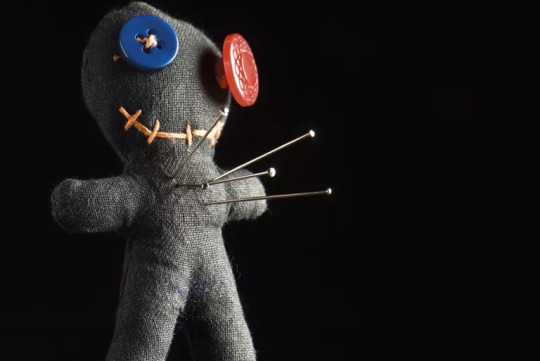
You're the only one who can decide what's ethically acceptable for you. Michelle Constantini/Getty Images
By Patti Wigington
Updated January 05, 2019
The magical poppet is one of the most commonly used implements in sympathetic magic, which follows along on the theory that “like creates like.” Although TV shows and movies typically show poppets as the stereotypical "voodoo doll," poppets have been around for a long time, and used in a number of different cultures and religious belief systems. There are many ways to create a poppet, and they can be used to harm or to heal; if you create a poppet of a person, anything done to the poppet will affect the person it represents. Bear in mind that some magical traditions discourage the use of poppets. If you're not sure whether or not it's okay for you to use poppet magic, you may want to check with someone in your tradition.
A poppet is usually made from cloth or fabric, but you can also make one from clay, wax, wood, or just about any other material. You can fill your poppet with herbs, stones, bits of wood, paper, or anything else that suits your needs. In addition to magical items, it's a good idea to include some cotton or polyfill as stuffing material.
Once the poppet is created, you'll need to connect it to the person it represents, which is typically done by using a magical link of some sort. Remember, the poppet is a useful magical tool, and can be used in a variety of workings. Use it for healing, to banish harmful people from your life, to bring abundance your way — the choices are practically limitless.
Poppet History
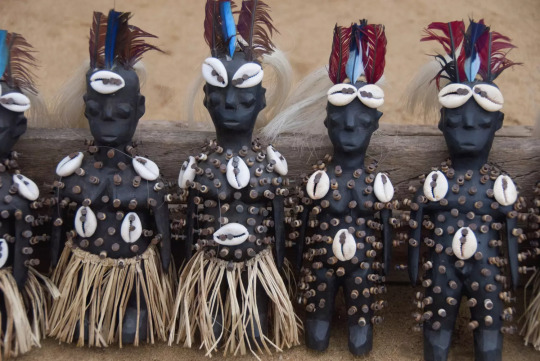
Fetish dolls on sale at a market in Togo. Danita Delimont/Getty Images
When most people think of a poppet, they automatically think of the Voodoo doll, thanks to this item's negative portrayal in movies and on television. However, the use of dolls in sympathetic magic goes back several millennia. Back in the days of ancient Egypt, the enemies of Ramses III (who were numerous, and included some of his harem women and at least one high-ranking official) used wax images of the Pharaoh, to bring about his death. Let's look at some of the historical uses of poppets in spellwork.
Greek Kolossi
It wasn't uncommon for the Greeks to use sympathetic magic in workings related to love or war. Christopher Faraone, Professor of Classical Languages and Literatures at the University of Chicago, is one of the foremost authorities on Greek magic today, and says that Greek poppets called Kolossoi were sometimes used to restrain a ghost or even a dangerous deity, or to bind two lovers together. In Idyll 2, The Witch (Pharmakeutria), written about 200 b.c.e., the tragedian Theocritus refers to melting and burning wax dolls. He relates the tale of Simaetha, rejected by Delphis, attempts to get her lover back with magic.
The Princess Who Played with Dolls
Wax dolls certainly weren't limited to the ancient classical world. The one-time Princess of Wales, Caroline of Brunswick, was married to the man who later became King George IV, and evidently couldn't stand him. She spent many hours forming wax dolls of her husband and jabbing them with pins. Although there's no concrete evidence as to what this may have done to George, when Caroline ran off to Italy with her young lover, George didn't object. The royal couple remained married but lived separately until Caroline’s death in 1821, according to Witchcraft and Evidence in Early Modern England by Malcolm Gaskill.
West African Fetish Magic
West African slaves brought with them a doll called a fetish when they were forced to leave their homes and come to the American colonies. In this case, the doll is not so much representative of an individual, but is in fact possessed by spirits connected to the doll’s owner. A fetish contains significant power and is typically worn or carried by its owner as a talisman. During America's Colonial period, slave owners were allowed to kill any slave found with a fetish in his possession.
American Hoodoo and Folk Magic
In American Hoodoo and folk magic, the use of poppets as a magical tool became popular following the Civil War. There is some dispute as to whether the dolls are used at all in Haiti, which is the home of Vodoun religion, and a few sources disagree on whether the use of poppets is truly a Vodoun practice or not. However, the Voodoo Museum of New Orleans does stock a variety of dolls in their gift shop.
Regardless of how you make your poppet — out of cloth, a chunk of meat, or a glob of wax, remember that poppets have a long tradition behind them, and that tradition is influenced by the magical practices of a wide range of cultures. Treat your poppets well, and they will do the same for you!
Make Your Own Poppet
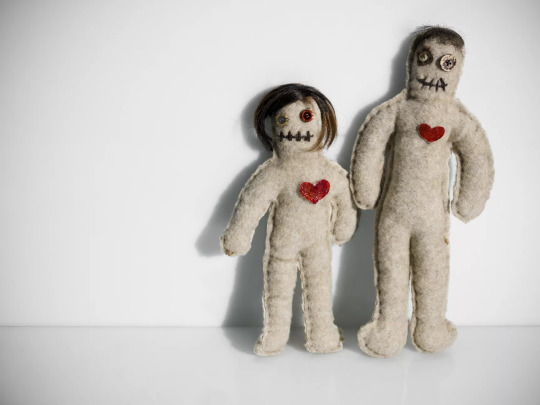
Photomorgana/Getty Images
A poppet can be as simple or as elaborate as you like — it all depends on how much time and effort you want to put into it. You can construct one out of just about any material — cloth, clay, wood, wax. Use your imagination! In some magical traditions, it's believed that the more work you put into it, and the more complex it is, the stronger your link will be to your goal. Because a poppet is a device for sympathetic magic, all of its components will be symbols of what it is you hope to achieve.
You can do your poppet-making as part of the working itself, or it can be made ahead of time so you can use the poppet later on. Which method you choose is really up to you.
Remember, your poppet represents a person, so figure out before you begin who it symbolizes. Is it you? A friend who's asked you for help? An un-named lover you want to bring into your life? A gossip you want to shut up? The possibilities are endless, but just like in any spell working, you'll need to set a goal before you begin. It keeps you from having to deal with "do-overs" later. These instructions are for a basic poppet construction, using fabric. Feel free to modify your design as you need to.
Selecting Your Fabric
There are no real rules when it comes to choosing your material, but it's not a bad idea to select fabric based on your goal. If you're doing a money spell, use a piece of green or gold cloth. If you're looking at healing, perhaps something in a soft blue or silver would be best. Check out fabric stores around the holidays, and you can find all kinds of neat patterns.
Valentine's Day designs are perfect for matters of the heart, and there are plenty of prints with dollar signs, coins, stars and moons, and other fun designs.
Another option is to use fabric that links the poppet to the person it represents. Doing a healing spell for a friend? Ask the person for an old t-shirt. If you're trying to draw love into your life, consider using a scrap from that sexy lingerie you wore last night. If you just can't find the right material, use a plain muslin or white felt. Here are a few ideas for designs and colors for poppet magic.
Animals: Brown or green fabrics, patterns with cats or dogs, anything pet-related
Banishing: Black fabric, designs such as swords or wands, dragons or fire
Creativity: Orange or yellow fabric, prints of suns or other fire symbols
Healing: Silver, white or blue, with designs of clouds or other air symbols
Love: Pink or red material, designs like hearts, roses or other flowers, Cupids
Money: Silver, gold or green fabric, or designs of dollar bills or coins, cups or earthy symbols
Protection: Red or white material, with patterns of shields, keys or locks, fences, mistletoe
When it comes to types of fabric, use what's easiest for you to work with. Cotton prints are easy to sew, but if you've never used a needle and thread before, you might want to try something stiffer like felt — it comes in every color you can imagine, and will hold its shape as you sew. If you're an experienced sewer, use anything you like.
A poppet represents a person, so ideally it should look (sort of) like a person. Give it a head, two arms, two legs, a torso. You can make your own outline or you can use the ultimate poppet pattern — a gingerbread man. If you're doing a spell for an animal — such as a healing spell for a sick pet — make the poppet shape accordingly. Your poppet doesn't have to be huge, but it should be big enough that you can stuff it with your ingredients later.
Take two pieces of your fabric, and place them right side together on a flat surface. Place the pattern on top, pin it in place, and cut it out. Leave a little room around the edges for a seam allowance — usually a 3/8" margin is good. Remove the pattern, and there are your two poppet shapes. Time to start sewing!
If you've never sewn anything by hand before, don't panic. It's not hard, but it does require some patience. You could always use a sewing machine if you're pressed for time, but most experienced poppet-makers agree that it's worth the effort to do it by hand. Pin the two pieces of material with the right sides together, and stitch around the edges. Leave an opening somewhere, wide enough to stick a couple of fingers in. Turn the poppet inside out, and begin stuffing.
Personalize Your Poppet
Fill your poppet with something soft, like polyfill or cotton balls. Old pantyhose work nicely too. Work the stuffing all the way into the nooks and crannies of the arms and legs, and then fill the torso and head.
This is where you'll place your spell components — herbs, stones, whatever. In some magical traditions, something from the person represented goes inside the poppet. This is alternately referred to as a taglock or a magical link — it can be bits of hair, nail clippings, body fluids, a business card, or even a photograph. Once everything is inside, sew the poppet completely shut.
The more you can customize your poppet, the better. Even if you've placed a magical link, or taglock, inside, you'll want to decorate the outside too. Draw or paint or sew a face onto your doll. Add yard or string for hair. Dress your poppet in something that looks like the person's clothing. Copy any tattoos, scars, or distinguishing features onto the poppet as well. Add magical or astrological symbols if you like. While you're doing this, tell the poppet who it represents. You can say something along the lines of, "I have made you, and you are Jane Jones."
Your poppet can be used for any number of things—love, money, protection, healing, to get a job. Anything you can imagine, you can make a poppet to bring it about. Simply figure out your goal and the means to achieve it. The only limits on poppet construction are your own creativity and imagination.
6 Easy Poppet Projects

Make protective poppets for each member of your family with modeling clay. amanaimagesRF/Getty Images
Not sure what sort of poppets to create, or how you can use them in a practical application? Try one of these six easy ideas for making and using your own poppets.
1. To Get a Job You've Applied For
Material: satin, green or gold or silver
Herbs: clover, chamomile, ginger, cinnamon
Gemstones: snowflake obsidian or sodalite
Create a poppet to represent yourself. As you make it, focus on the positive attributes that you possess which will make you appealing to a potential employer. Another option is to create the poppet in the image of the employer (include business cards or letterhead inside, if you can get them) and tell the employer poppet why you're the best person for the job.
2. To Protect Your Family
Material: Modeling clay
Herbs: Basil, patchouli, coffee
Gemstones: Hematite, amethyst, black onyx.
Create poppets that represent each member of the family, blending herbs and stones into the clay. Put them in a safe place in your home, such as near your hearth, and utilize magical shielding or cast a circle of protection around them. This is actually a fun project you can get your kids involved in as well — let them each make their own poppet person!
3. To Heal a Sick Person
Material: White cotton or unbleached muslin
Herbs: Lemon balm, feverfew, ivy, and pine.
Gemstones: Bloodstone, turquoise
When you make this poppet, be sure to indicate what you are trying to heal, whether it's a case of tennis elbow, a chronic infection, or even a broken heart. Focus all of your energy on the ailment in question.
4. To Bring Love Into Your Life
Material: Red or pink silk or cotton
Herbs: Rose petals, parsley, and peppermint
Gemstones: Barite, jade, rose quartz
Make a poppet to represent the object of your affection — remember that in some magical traditions it is frowned upon to make a specific person the target of your working. If you are simply trying to attract love to yourself, but you don’t have a specific person in mind, focus on all the desirable qualities you want to see in a potential lover.
5. Silencing a Gossip
Material: Ground beef or other squishy meat
Herbs: Horseradish, pepper, rue, yarrow, valerian
Shape the meat and herbs into a person, and create a "meat puppet" in the same way you'd make a fabric one. As you make the doll, tell it that it's time to be silent, and tell no more gossipy stories. Remind it that people who can't say nice things shouldn't say anything at all. Dispose of the doll by either burning it on your grill and burying it someplace far away, feeding it to your dog, or leaving it out in the sun to rot.
6. Emergency Poppet on the Fly
Material: Aluminum foil
Perhaps something has come up in a hurry, and you feel it needs immediate magical attention. Use a piece of aluminum foil to whip together a quickie poppet — shape it into the figure of a person. Fill with any magical components that might be handy — bits of wood, dirt, grass, even a name scribbled on a piece of paper — and personalize the poppet.
Need additional poppetry ideas? Try making a magical gingerbread poppet, or put together a portable poppets kit to keep in your magical arsenal!
https://www.learnreligions.com/what-are-magical-poppets-4072783
10 notes
·
View notes
Text
Black cats and Gambling Dens: The Story of an Edwardian Perfume

(cw: mention of animal abuse)
The perfume Pompeia was created by L.T. Piver in 1907, and its original image could not possibly have been more respectable. The scent of patchouli and rose was sweet and ladylike, and the image of the graceful stola-clad woman on the label evoked the image of the classical past. The name could not have been chosen better - after all, Pompeii was one of the most haunting and popular tourist destinations for centuries, inspiring both entertaining novels and thinkpieces about the lost civilization.
The worst thing that could possibly happen to the perfume in the future, it seemed, was that it’s going to become accessible, commonplace, and associated with badly-lit cafes and vulgar women like the same creator’s earlier hit, Le Trèfle Incarnat.
And now I’m going to make a brief aside about the world of Edwardian gambling.
I promise, the reason is going to become clear in a couple of minutes.
Now, the issue of gambling in the Western world of pre-WW1 was a somewhat complex one. And when I say complex, I mean hypocritical. On one hand, the attitude towards it was much stricter than we have today - for instance, the sleek new ocean lines like the ill-fated Lusitania prohibited it altogether. On the other, once out of the bright light, it blossomed like orchids on the moors. The stewards of the aforementioned Lusitania tended to look the other way as elegant husband-and-wife teams of cardsharps used complex eyebrow codes to communicate with each other while fleecing the passengers (#relationshipgoals?). Then, of course, there was also the 1%, who could wager to their heart’s content during private parties and cozy country house weekends (or, as they called it, the Saturday-to-Mondays - after all, calling it a weekend would be implying that you also have a working week. Quelle horreur). Sometimes sums as high as £10,000 – enough to buy a Georgian house with its own deer park - were lost in the games of baccarat and chemin-de-fer. Indeed, some of those private parties in the West End became so cozy that they eventually turned into fully-fledged, if exclusive, gambling salons. Losers in these establishments were cheered up with a doze of good brandy, and servants were at hand to make sure particularly unfortunate debtors would not try to shoot themselves in the house’s conservatory. Of course, mishaps still happened. When one such salon was raided by the police, a young lady whose name the memoirist Eric Horne discreetly left out, slid down a drainpipe in panic right in her evening gown, petticoats and all. Ouch.
It’s not surprising, therefore, that people who frequented gambling dens wanted to use any trick and mojo possible to attract some luck to their often-shaking hands.
What occurred next, however, is surprising indeed. Just when the popularity of Pompeia swept the southern states of America like a wave, it collided with another, much mightier force: the craze for the hoodoo and voodoo among the white population. These practices of folk magic initially arrived in the Mississippi Delta by way of slave routes from West Africa; fast forward a hundred years, and the patrons of gambling dens of New Orleans wanted to use it to help them win a jackpot.
A whole slew of recipes for concoctions one could use for hoodoo spells was printed. One urged the readers to boil a cat alive and then grind his shoulder bone into ‘Black Cat Dust’. Fortunately, most readers in question preferred more bloodless ways: and this is where Pompeia came in. Maybe because of its association with the ancient pagan town, or maybe because of some other reason, it became known as a ‘spiritual cologne’ one ought to sprinkle on the lucky charm to attract the attention of the gods.
As, in the aftermath of the Second World War, L.T. Piver’s fortunes declined, Pompeia forgot its worldly origin and retreated completely into the world of witchcraft stores. Some said you could increase your psychic power if you draw a bath with honeysuckle and a few drops of Pompeia.
Sources:
Lusitania: Triumph, Tragedy, and the End of the Edwardian Age by Greg King
Perfume: a Century of Scents by Lizzie Ostrom
The Perfect Summer: England 1911, Just Before the Storm by Juliet Nicholson
#edwardian history#edwardian#victorian era#victorian#victorian age#victorian history#american history#history#british history#1900s#1910s#perfume
51 notes
·
View notes
Text
New Years Protection - A How To Guide

Every year I protect myself from negative people, bad intentions, flaky energy and all manner of bad spirits and you should too.
What is New Years?
New Year is the time or day at which a new calendar year begins. Many cultures celebrate the event in some manner, and the 1st day of January is often marked as a national holiday holy day.
New Years is holy because it’s number is 1. The numerology number 1 is self-determined and self-sufficient. It goes about its own business, pursues its own goals, and has no need for companionship.
Often, we create New Years resolutions and goals that reflect the energy of the number 1. However, near March of that same year, we have likely quit or goals or had something happen to throw us back into old behavior, circles, thoughts and energies. What happened to our vigor and will power?
Many of us have bad luck, bad juju, roots and other negative things on us that keep us from our goals in life. We often have terrible relationships, situationships and sinking ships that we choose to stay in for far too long. Each year, I do spells to keep haters, spells, hexes and much more away and now I wil share a few “secrets” with you.
Spiritual Baths
Cleanliness is next to Godliness.
Most empaths come home with residual feelings and energy each day. When they ask me for tips, I always suggest a spiritual bath. I use Bobby Hemmitt’s bath and it’s my go-to method but it’s not for every one.
What you’ll need
Huge tub of water, 3 caps ammonia, 3 caps of bleach, 3 caps of apple cider vinegar, 3 caps of lemon juice and half a cup of sea salt, 1 white candle.
What you’ll do
Light the white chime candle. Get in that tub and imagine your aura extending out into a white light all around you. Stay in for a minimum of 15mins and then before you leave the tub, dunk your head below the water. After that, shower off and take some of the left over wax and ball it up in some cloth and wear it on your body.
This bath helps with prosperity, protection, and removal of anything negative.
Great video on it below:
youtube
Baths have always been sacred. In hoodoo and may other spiritual systems, baths can be used as a very extremely powerful tool to help you manifest on your journey in the New Year.
The Witches Bottle
If you ain’t got haters, you ain’t poppin’! Every time you get somewhere in life, BOOM, a hater. Some of those haters are witches and they don’t mind playing target practice with your life. Personally, I lay a few tricks of my own when I create a witches bottle each New Year.
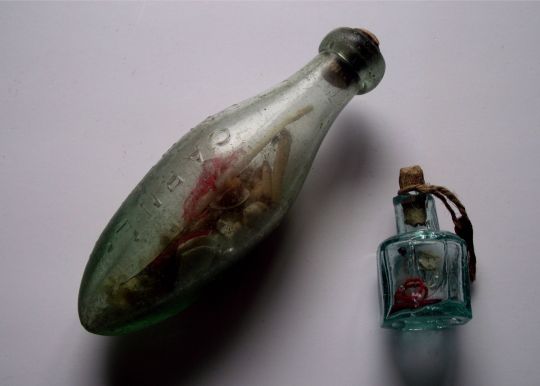
What is a Witches Bottle?
Witch bottles began as countermagical devices used as protection against other witchcraft and evocation. They are described in historical sources in England and the United States. The first mention of a witch bottle appears in the 17th century England.
This is old-school magic that works! You make a bottle for you, your spouse or kids to keep them safe from magical harm. The idea is that a evil spirit or energy will seek you out but mistake the witches bottle for you becoming trapped or destroyed in the process.
What you’ll need
A glass bottle and closure, toe/fingernail clippings, hair, urine, seamen/menstrul fluid for extra points, a black candle, red twine (optional), nails, rose thorns, any protective herbs or salts.
What you’ll do
You’ll fill the witches bottle with bodily fluids, salts, hair, bones and then seal it closed. On top of the bottle, you’ll burn a black candle. Let the candle wax drip down the sides. As the candle burns, imagine all evil being trapped into what looks like a projection of you but it’s really the bottle. When the candle is done, take the bottle and place it in a quiet place or bury it in your front yard. If you stay in an apartment, bury it at your mother’s house or a place you frequent.
Witches bottles are a huge deal and they even get major press when people find them: https://www.washingtonpost.com/history/2020/01/24/witch-bottle-discovered-virginia/
A New Years Reading with Tarot
The last thing I do for the New Year is read my energy with the Tarot cards. Tarot allows us to see current energy and make choices that can influence future events.
What you’ll need
A decent tarot deck, my suggestion would be https://amzn.to/2KMGDMc for a solid deck that shows Black ppl instead of the traditional tarot characters.
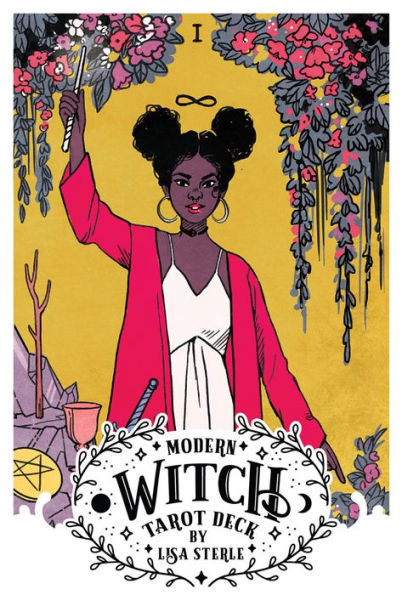
Purchase yours at https://amzn.to/2KMGDMc
What you’ll do
A simple 4 card spread. Shuffle the cards and think about the next year. Think of all you want to do and achieve while letting your mind wander away from the thoughts of the cards. As you shuffle, ask your ancestors that work for your success to help you “know, what is unknown”. You should get the word “STOP” in your head or cards will leap out of the shuffle when it is time to draw your cards.

Using the spread layout, pull the first card (your past), then the second card (your future), next the third card (your now) and the last card (your outcome). Use google to find out the meanings or the accompanying book that comes with your tarot card deck.
I hope you take the time to make this a very good year for you and your loved ones and book a session with me if you’d like to have a Root Doctor pull your cards.
J-Lamar
#youtube#altarsofinstagram#altar#hoodoo#conjure#rootwork#afro witch#occult#new year#blacklivesmatter#blackwitchesofinstagram
15 notes
·
View notes
Text
I wish we knew more about Mambo Marie. I’m currently working on the next chapter of Sir, Spare Your Threats, and while I know it’s an alternate universe anyway, I still wish I had more canon background to go on, because I like to use canon as the basis of my ideas.
So I’ll pose all these questions to you:
How long ago did Marie move to New Orleans? Was the move made specifically because her met-tet told her ‘something’ was coming, or was it for another reason (the earthquake, perhaps)? Also, if her met-tet was drawing her towards the New England witches, why did she go to New Orleans first and not directly to Greendale (yes, I know, magic has its limits and such...but still).
I'm just unclear as to why Marie, a High Priestess and thus cornerstone of her community, would leave Haiti for New Orleans, especially if she wasn’t interested in pretending to do “hoodoo-vodou bullshit.”

12 notes
·
View notes
Text
Lynchings were (and are) public RITUAL events, where bible verses were often read, and White religious and cultural leaders were present. The murder of black folks as PUBLIC RITUAL WORK. Black bodies as offering to White Supremacy. This is the subtext.
This is still the case w your police officers being Klan members, often with deep deep ties in the South, and in our Midwestern states and yes my sweet Liberal California and New England y’all too...
I think it’s important to discuss that EVERYTHING eats. You, your plants, spirits of nature, and those big giant institutions we worship and uphold. What does Capitalism eat? Everyone, but namely black folks.
Eating happens through ritual work, but when we feed a spirit there is always sacrifice, When you leave offering it is a sacrifice of food, energy, resources/money to feed your ancestral spirits. What do they feed White Supremacy? What does it EAT?
This is why the discussion of what happens in ADR & ATR is closed, especially around blood. Becuase the privilege that white folks are standing in is ROOTED in blood sacrifice, and continual energy stealing. This is about a lack of energy and power. Energy war.
As I speak esoterically don’t think that this is your floaty “energy lightworker convo” they are KILLING US. For ritual confirmation, and out of loyalty to systems. Killing is to stay in alignment with what they worship. And their systems say it is OKAY TO DO SO.
I found Hoodoo in my bones, and family but when I found African based cosmologies it changed my world. It still changes my world on the daily. We have systems that validate us, protect us, and feed us. We don’t have to martyr ourselves in a system built to eat us.
Africans, what do we eat? I think folks have touched on this and speculated on physical consumption, I’m not there w it. I’m talking spiritually? What do we need? What do our spirits eat?
As we rebuild and deconstruct systems revisit your ancestral spaces and feed them. Feed yourself, leave offering to yourself. Your things will save you. Theirs, aren’t built to.
- Twitter.com/IamSatarra
9 notes
·
View notes
Photo

AO3 Link (HERE)
Chapter 17: Clarke (V)
Numb.
It’s the only word that comes to mind for the out of body sensation that Clarke is currently experiencing.
Everything is numb.
No anger.
Or sadness.
Or even fear of what’s to come.
It’s as if her inner catalog of tried and true emotions are suddenly nowhere to be found, leaving Clarke with the inability to feel anything…
Anything at all.
All there is is the never-ending abundance of numbness.
“Time to go, Blondie,” Anya announces from somewhere in the near distance. But Clarke doesn’t move. She remains planted on the top step of Murphy’s front porch, arms wrapped around her legs and chin resting upon her knees, while her eyes stare out into the darkness before her.
A distinct set of footsteps cut through the ongoing background party noise, growing closer and closer, until stopping right beside Clarke. A moment or two of silence passes and then she notices the all too familiar sound of Anya letting out one of her “What mess did my sister create now” signatures sighs.
Clarke knows that sound.
It’s the one that has become synonymous with Anya throughout the years, as time and time again the older Woods sister has managed to step in at just the right moment and fix whatever mess that Lexa has caused. The sigh comes first. Then the silence while Anya works her magic to rectify the situation at hand.
Words come later. Always firm and direct, but never with a tone of anger. And never too many neither. It’s always just the right amount to get her point across before moving on.
Clarke feels the sudden weighted warmth of Anya’s leather jacket around her shoulders and can’t help but shrink into it, desperate for any sort of comfort at the moment. She blinks away the hint of tears forming within the corners of her eyes as Anya ever-so-gently helps her up onto her feet and leads her down the front steps.
The two walk side by side in silence down the street and back towards Lexa’s car, with only the occasional street light to guide their way. Clarke doesn’t need to ask where they are going. She already knows. Anya is taking her home.
It’s always the first step when it comes to cleaning up the mess.
Everyone is taken home-- and to their own home only-- and is required to get a good night’s sleep. Then, and only then, can they reconvene with one another. Usually over bacon, egg, and cheese sandwiches and coffee at Blue’s.
That’s the ritual.
Always.
Clarke slides herself into the passenger’s seat and buckles her seat belt as Anya gets situated. “What about Rae and Octavia?”
“Took off. Saw the two of them leave together about 20 minutes ago. Guessing they got an Uber or something.”
Clarke nods. “Lexa left too.”
“I know. My sister is an idiot,” Anya responds, never once taking her eyes off of the windshield. “A massive fucking idiot.”
“No, it’s my fault, I was the one--”
“Don’t. You’ve got nothing to apologize for.”
“But, I--”
“No. This is not your fault.” Anya turns and briefly locks eyes with Clarke. “And it doesn’t matter what you think you did or didn’t do. This one’s all on my sister.”
Clarke wants to believe Anya’s words, but the overwhelming guilt residing in the depth of her stomach is just too all-consuming. She shakes her head as a fresh set of tears reemerge in the corners of her eyes.
Anya steals another quick look at Clarke and then exhales. “Look. I don’t know what went down between you and my sister tonight, but my guess is that Lexa pulled her normal shut down and run away bullshit.”
Clarke once again swallows back down her tears and then gives the tiniest of nods in confirmation.
“So fucking predictable,” Anya mutters under her breath. “Now she’s gonna run her ass all the way to England.”
England.
The word slams into Clarke like an unexpected slap to the face. She straightens herself up a bit within the passenger’s seat as her brow furrows with confusion.
Lexa is going to England?
No.
That can’t be right.
It’s the alcohol playing tricks on her.
She’s drunk and misheard Anya. That’s all.
Lexa’s not leaving. Not in the middle of their senior year. Why would she?
They are supposed to be going to UCLA together.
Lexa would’ve said something to her if their plans had changed… Wouldn’t she?
Stop.
It’s the alcohol.
Lexa’s going nowhere.
They’re in love.
And people in love don’t up and go halfway around the world without saying something.
Those things just don’t happen.
Clarke closes her eyes and shakes her head, trying to clear away her snowballing thoughts from her mind. She grabs the edges of Anya’s leather jacket and pulls it closer to her body as a strange set of chills washes over her.
Something still doesn’t quite feel right…
“Cold?” Anya asks.
“Yeah. A little bit.”
Anya reaches over, turns on the heat, and then repositions the vents to blow towards Clarke. “Here. It should take a minute or two, but then it’ll warm-up.”
“Thanks.”
Anya nods. “Used to it. Lexa is always freezing too. She would drive with the heat on in July if she could… She should’ve been born on some tropical island. Like Hawaii or Fiji.”
The smallest hint of a smile appears on Clarke’s face. She more than knows what Anya is talking about. It’s one of Lexa’s most endearing quirks. The insatiable craving for warmth.
And it goes beyond just her normal wardrobe staples of oversized hoodies and thick fuzzy socks. No. Lexa constantly needs continuous warmth, both inside and out, in order to thrive. Otherwise…
“It’s gonna be alright,” Anya says, cutting through the silence once again. “I’ll drop you home and then go hunt Lexa’s ass down and knock some sense into her. Everyone just needs to sober up and get some sleep. Tomorrow things will return to normal. You’ll see. You won’t even get a foot in the door before Lexa starts to apologize and beg you to forgive her.”
“Yeah,” Clarke replies with an underlying tone of uncertainty to her voice. She so desperately wants to believe that Anya’s right. That by tomorrow morning everything within the world will return to back to normal and the events of tonight will slowly fade away like a forgotten nightmare. And yet…
Something still isn’t right.
Clarke can feel it circling around her like an invisible entity that only she can sense, just waiting for the opportune moment to rear its ugly head and bring further havoc into her life.
But what is it?
And what does it have to do with Lexa?
__________
“Hey Blondie,” Anya says with a drugged-up husk to her voice. ��Back again?”
But Clarke doesn’t respond right away. She instead quietly slips into the hospital room and shuts the door behind her, letting the definitive click of the lock speak for her.
Anya quirks her brow as she tries to decipher the reason behind the peculiar action. “You know you don’t have to lock that thing. It’s not like I can up and go anywhere.”
“It’s not for you. It’s to make sure we aren’t interrupted by any random pop-ins,” Clarke replies. She pulls up a nearby chair to Anys’s bedside and takes a seat. “We need to talk.”
“Okay…”
Clarke goes to open her mouth but suddenly finds that the words that she’s been rehearsing in the confines of her own head ever since leaving Raven’s hospital room are now nowhere to be found. As if they’ve evaporated into mere nothingness, leaving Clarke with not an inkling of where to even start.
It’s Anya.
The same Anya that would cover for Clarke all those times back in high school when she would fall asleep in Lexa’s bed and forget to get up before Indra awoke. The one that helped her bail Raven and Bellamy out of jail, no questions asked, after they were caught rebuilding a ‘76 mustang in the principal’s office. And the one that was ultimately left to clean up Lexa’s mess when she ran off to Cambridge.
“Clarke… What is it?”
Clarke blinks and then inhales deeply. She can feel Anya’s eyes upon her. Observant as ever. “I went to see Raven.”
“Yeah? How’s she doing? Is she okay? I asked one of the nurses but they wouldn’t say jackshit to me. Something about patient-doctor confidentiality or some other bullshit like that.”
“She’s awake.”
“And…” Anya impatiently follows up, too eager to wait any longer.
Clarke bites her lip a little too hard, almost breaking the skin.
Where the hell did her words go?
“Clarke?”
“You need to go see her.”
“I would if I could. You know that. But they won’t even let me get out of bed by myself to go take a piss,” Anya responds and Clarke senses a hint of hostile growing within the depths of her voice. “Tell me what’s going on. Something’s wrong, isn’t it?”
“I--”
“Don’t do it, Clarke. We had a deal. No bullshitting each other. Not when it comes to the hard stuff. Remember? That was the deal you and I made after Lexa left,”
“I know,” Clarke responds.
“Okay. Then answer my question… What’s wrong with Raven?”
Clarke exhales and runs her hands through her short, messy locks as she mentally shifts herself into doctor mode. “During the crash, Raven suffered what is called a partial dislocation of the L3 vertebra. This means her spine shifted from the impact, causing a severe amount of swelling and trauma to the surrounding nerves. Right now, it’s too soon to say if there’s any permanent damage, but…”
Clarke trails off as her words fail her once again. She’s done this a thousand times before. To face a patient’s loved ones and have to explain the extent of damages. It’s the first major test that any pre-med intern goes through. And up until this point, Clarke has always passed with flying colors. So much so, that she has gained the unwanted reputation of being a “Hoodoo”.
A deliverer of bad news.
But now…
Now it’s different.
Now the person she is talking about isn’t some generic-named stranger, but someone that is part of her life.
Now the person is Raven.
“But?” Anya asks unable to hide the quiver in her voice.
“But for right now Raven is experiencing roughly 75% paralysis of both of her legs.”
The words explode like a shrapnel-filled grenade, emotionally shredding Anya on impact. Clarke watches as Anya’s unreadable mask shatters, giving way to two defined trails of tears. “She’s paralyzed?”
Clarke nods. “Yes.”
“Does she know?”
“Not sure. She didn’t let on to it when I was with her, but she’s lucid enough to at least know something isn’t right. And given that it’s Raven, she’s already put two and two together by now.”
The tears continue to flow freely down Anya’s cheeks as she takes a moment to process the gravity of Clarke’s words.
“I talked with Jackson and they’re planning on doing another set of scans in a few hours from now. The hope is that by then the swelling will have subsided enough to get a better picture of what’s causing the paralysis. It might even just be due to the initial trauma of the impact itself. In fact, once it goes down, there’s a strong likelihood that Raven might just naturally regain full functionality and feeling on her own. I’ve seen it happen before. At least a half dozen times. There’s was this motorcycle accident back in August where--”
“Clarke.”
Clarke stops rambling and catches hold Anya’s eyes. The tears have now slowed down but still, the look of pure uncertainty remains written across her face and Clarke is instantly transported back to that fateful night. It’s the only other time when she’s seen Anya look this way. Terrified of the unforeseen disaster that is lurking just off in the horizon.
The unpredictable.
“It’s going to be alright.” The words tumble out of Clarke’s mouth before she can process what she is actually saying. She cringes, bracing for the inevitable response, but instead is greeted by a soft laugh.
“Nice try, but you and I both know that phrase is like the kiss of death.”
“I know,” Clarke sighs. “But maybe this time things will be.”
“Maybe…” Anya replies with a less than believable tone. She lets out a long exhale of air and then--
“I need to see her.”
Clarke nods in agreement. “Yes, you really do.”
22 notes
·
View notes
Photo

// THERE IS NO WORD FOR YOUR DOG //
This week I said goodbye to Tommy, my 14-year-old rescue basset hound and best goddamn friend in the world, and I am all kinds of messed up.
Tommy was already a senior when he came into my life at the age of nine—the oldest of a group of five bassets rescued from the worst backyard breeder that the rescue had seen in their decades of work. Fresh off a tail-amputation surgery to remove a follicle cancer tumour so big he couldn't wag his tail anymore, and still on roundworm medication, he burst into our lives and claimed a spot on the couch like this was the home he always knew he'd find.
Despite the abuse he'd been through, Tommy was kindness incarnate: impossibly pure, loyal, loving and gentle. Even dogs with histories of aggression and kids with a fear of dogs felt comfortable around him. So many times, other dog owners told me "My dog likes him, and my dog doesn't like ANYONE." Even last week I heard someone yell in surprise and delight as I carried Tommy down the stairs because she'd legit mistaken him for a literal teddy bear.
Tommy helped our older basset Roxy live longer by becoming her little brother and bringing out her competitive big-sister edge, and he never begrudged her getting more of our love and attention as her age and needs increased. When we lost Roxy to cancer in 2015, Tommy helped us through the grieving and healing process and we really got to see his explorer's personality come out.
At the age of 13, he joined us on our 8,000-kilometre round-trip cross-country road trip to be the ringbearer at our wedding. He made it right to the end of the Trans Canada Highway in Tofino, wandered through ancient cedar forests and log tunnels in BC, charmed a comfort food restaurant owner in Manitoba into giving him a bowl of ham, wandered through hoodoos in Alberta, and looked out over waterfalls in Ontario.
His adventures took us far and wide. He travelled by train, subway, streetcar, bus, car, ferry and airplane. He dipped his paws in both oceans. He spent an eight-hour day walking around Halifax with us. He joined us hunting for fossils in Joggins on beaches where Darwin found some of the first evidence for evolution.
He was also patient as a loving older sibling to five foster brothers and sisters who stayed with us. Despite the fact that he was getting on in years, he made room in his quiet home for five very different and variously loud personalities who, just like Tommy, all came from their own difficult backgrounds and particular needs.
When he was diagnosed with an aggressive osteosarcoma in July, he was given one to three months to live. We were told there was a 0% chance he'd be fit enough to travel with us to England in the fall, even if he lasted that long. Tommy had other plans. With each subsequent vet visit, his oncologist was shocked to find that Tommy was getting healthier and his lungs were clearing themselves of fluid when that should be impossible.
By November, well past the most wildly optimistic lifespan estimates, he had recovered to the point that he was cleared for air travel by two different vets. And so we made a new home together in London, England, explored the city, walked Hampstead Heath and Waterlow Park, ate crepes, and met some jolly English bassets. Having him around on my 30th birthday in November meant absolutely everything to me, and staying in to celebrate Christmas and New Year's Eve with him was an absolute gift. I wish the miracle of his good health could have gone on forever, but he stopped eating in early January and in the last couple days his breathing became increasingly laboured. We kept him comfortable as long as we possibly could before making arrangements to say goodbye.
Tommy taught me so much about how to love, how to wander, how to be brave and gentle at the same time. That's the word he taught me.
And I wanted to share it with all of you.
913 notes
·
View notes
Photo

Pagan, the magazine for people bored with National Geographic. Jan-Mar 1966.
2 notes
·
View notes
Text
My Love of the Southern Gothic Horror Genre
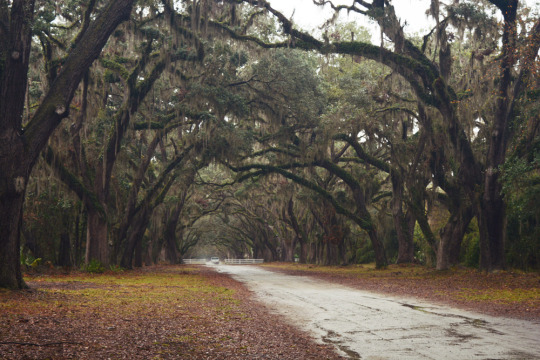
I’ve always been drawn to the Southern Gothic Horror Genre, with anything from Flannery O’Connor’s Short Stories, to William Faulkner’s Sanctuary, and Anne Rice’s Vampire Lestat Series. It’s a genre I want to dabble with for my next story idea, but am concerned that I won’t nail it right, as I am not from the South, let alone from the U.S. For those of you who do not know, Southern Gothic is a sub-genre of Gothic fiction in American literature that takes place in the American South, and includes deeply flawed, disturbing or eccentric characters who may be involved in hoodoo, decayed or derelict settings, grotesque situations, and other sinister events relating to or stemming from poverty, alienation, crime or violence. Southern Gothic writing is thus an extension of Gothic fiction, which originated in England in the 18th Century, and includes novels such as Horace Walpole’s The Castle of Otranto (1794), and Mary Shelley’s Frankenstein (1818). These novels all contained elements of horror, death and romance, often revolving around events that appear to be supernatural, but which ultimately have a natural explanation. Furthermore, the word ‘gothic’ can be taken as an historical reference to the Goths, the people responsible for the first known example of Germanic language during the 4th to the 6th Centuries AD. It denotes the Dark Ages, and the brutality, horror, and decadence associated with this period. It also refers to Medieval architecture; location is very much a character in itself in these novels, which often take place in castles, manors, and monasteries.
The popularity of Gothic fiction could also be seen across Europe: Germany’s Schauerroman (shudder novels) were much darker than their English counterparts, and stories such as Carl Friedrich Kahlert’s (writing as Ludwig Flammenberg) The Necromancer; or, The Tale of the Black Forest (1794) and Carl Grosse’s Der Genius (1796) contained a greater focus on necromancy and secret societies. European Gothic fiction was used by authors to delve deeply into their history, allowing its audience to experience the thrilling terrors of the dark past, which was naturally echoed in the American Southern Gothic tradition.
Elements of a Gothic treatment of the South were apparent as early as the 19th Century, in the grotesques of Henry Clay Lewis and the de-idealised visions of Mark Twain. However, the genre came together only in the 20th Century, when dark romanticism, Southern humour, and the new literary naturalism merged into a new and powerful form of social critique. The thematic material was the result of the culture existing in the South following the collapse of the Confederacy, which left a vacuum in both values and religion that became filled with poverty due to defeat in the Civil war and reconstruction, racism, excessive violence, and the theological divide that separated the country over the issue of slavery.

The Southern Gothic style employs macabre, ironic events to examine the values of the American South, thus, it uses the Gothic tools not just for the sake of suspense, but also to explore social issues and reveal the cultural character of the American South, with the Gothic elements often taking place in a magic realist context rather than a strictly fantastical one.
Warped rural communities replaced the sinister plantations of an earlier age, and in the works of leading figures such as William Faulkner, Carson McCullers and Flannery O’Connor, the representation of the South blossomed into an absurdist critique of modernity as a whole.There are many characteristics in Southern Gothic Literature that relate back to its parent genre of American Gothic and even to European Gothic. However, the setting of these works is distinctly Southern. Some of these characteristics are exploring madness, decay and despair, continuing pressures of the past upon the present, particularly with the lost ideals of a dispossessed Southern aristocracy and continued racial hostilities.
Southern Gothic particularly focuses on the South's history of slavery, racism, fear of the outside world, violence, a "fixation with the grotesque, and a tension between realistic and supernatural elements".Similar to the elements of the Gothic castle, Southern Gothic gives us the decay of the plantation in the post-Civil War South. Villains who disguise themselves as innocents or victims are often found in Southern Gothic Literature, especially stories by Flannery O'Connor, such as Good Country People and The Life You Save May Be Your Own, giving us a blurred line between victim and villain. Southern Gothic literature set out to expose the myth of old antebellum South, and its narrative of an idyllic past hidden by social, familial, and racial denials and suppressions

The term "Southern Gothic" was originally used as pejorative and dismissive. Ellen Glasgow used the term in this way when she referred to the writings of Erskine Caldwell and William Faulkner. She included the authors in what she called the "Southern Gothic School" in 1935, stating that their work was filled with "aimless violence" and "fantastic nightmares." This is a sentiment that has been expressed less and less, as it’s seminal authors, such as Flannery O’Connor, become lauded as being some of the most important icons in American literary history.
Of course, the genre also exists in film and television, with movies such as The Gift, and TV series like American Gothic and Season One of True Detective, the latter being one of the greatest TV shows of the last 10 years. The first series of True Detective, in addition to its Southern Gothic setting and characters, incorporates many of the core aspects of Gothic fiction, as well as drawing on the work of specific American horror authors, notably Lovecraft, Chambers and Ambrose Bierce. The setting is truly breathtaking and depressing in it’s dilapidation, and it’s clearly poverty-laden surroundings, as well as it’s troubled but fascinating key characters. Every time I watch the series, I imagine what it might have looked like if it was in the form of a written novel instead of a television series.

But I digress. As much as I love this genre, my personal experience of the American South is restricted to visiting Florida on holiday for three weeks when I was 10, so I think that I might steer clear of writing the next great American Gothic horror novel for the moment. Instead, I might focus on a writing project centring around European Gothic horror, as I lived in Norway for 6-and-a-half years. Norway, with its bitterly cold autumns and winters, and sweeping fjords and mountains creating great chasms between communities seems like an ideal setting for writing a good Gothic novel. I am even privy to the fact that Norway is home to an infamous, long-since abandoned mental asylum, which housed the criminally insane and where lobotomies and mysterious, unsolved deaths involving patients were commonplace. So, this will be the setting for my next novel, and my American-style Gothic horror story will have to wait. Stay tuned.
#novel writing#bayou stories#american gothic#european gothic#just write#gothic age#norway#livinginnorway#living in europe#leir#history lesson#history of the south#origins#novel ideas#flannery o'connor#william faulkner#mary shelley#the gift#true detective#carson mccullers#ludwig flammenberg#carl grosse#the necromancer#the castle of otranto#frankenstein#shudder novels#the dark ages#the dark ages history#goths#anne rice
18 notes
·
View notes
Text
Famous and Hidden “ Natural Wonders “ in the U.S.
From Japan's Mount Fuji and Australia's Great Barrier Reef to South Africa's Table Mountain and Israel's Dead Sea, the world is absolutely brimming with au naturel attractions. Of course, this is no surprise to anyone, but what might be is that you don't have to book an expensive flight to see some of the most intriguing places. Whether you're interested in singing sand dunes, flame-lit waterfalls, or prehistoric swamps, we've found 23 off-the-beaten-path natural wonders in the U.S. that will blow your mind.
1 Bisti Badlands, New Mexico

Hoodoos, prehistoric swamps, desert spires—New Mexico's Bisti Badlands has all this and more. The 45,000-acre swath, which stretches out across the Four Corners region, may now be arid desert, but it was once—65 million years ago—an inland coastal area home to early relatives of the Tyrannosaurus rex. To see what the best park in your state is, check out This Is the Best National Park in Each State.
2 Fern Canyon, California

Fern Canyon is located a few miles within Prairie Creek Redwoods State Park. If you've never been there but it looks oddly familiar, perhaps you've seen the lush, fern-covered canyon in Jurassic Park 2: The Lost World? The verdant one-mile trail forms a natural maze with walls that grow closer and taller the farther you walk. The leafy environs shade a number of amphibians, as well, including the Pacific giant salamander—so keep your eye peeled.
3 Craters of the Moon National Monument & Preserve, Idaho

Equidistance between Boise and Yellowstone National Park lies Craters of the Moon—a 1,117-mile preserve that encompasses three major lava fields. The Rhode Island-sized area formed between 15,000 to 20,000 years ago as lava erupted from the Great Rift, and today it's home to the largest-known open rift crack in the world. For more beautiful locations in America, check out the 30 Places So Surreal You Won't Believe They're in the U.S.
4 Pictured Rocks National Lakeshore, Michigan

Ireland has the Cliffs of Moher and England has the Cliffs of Dover, but what does Michigan have? Well, Pictured Rocks National Lakeshore, of course! The Upper Peninsula park includes 15 miles of mineral-stained cliffs, which borrow their color from iron, copper, manganese, and limonite deposits. At their tallest, the cliffs tower 200 feet about Lake Superior, making for a pretty incredible kayaking backdrop.
5 Kelso Dunes, California

The Mojave Desert is no stranger to sand dunes, but the Kelso Dunes aren't your average find. The 45-mile quartz sand deposit includes five distinct dunes—each the result of a specific period of climate change over the last 25,000 years. As wind moves through the area's vegetation, the sand "sings," letting off a low-frequency rumble that still has scientists scratching their heads as to why.
6 Eternal Flame Falls, New York

Of all the elements, water and fire usually don't get along the best, but at New York's Eternal Flame Falls? Well, it's a different story. Tucked into the Shale Creek Preserve about 30 minutes south of Buffalo, the 30-foot cascade harbors a small, natural gas-emitting grotto that fuels an "eternal" eight-inch flame. For little-known travel spots, check out the 33 Utterly Amazing Travel Destinations in the U.S. You've Never Heard Of.
7 Palouse Falls, Washington

Coursing water is no match for stone—just ask Washington's Palouse Falls. The cascade carved out its spot some 13,000 years ago and is one of the last active waterfalls on the Ice Age flood path. At sunset, the dancing shadows make the 200-foot drop even more enchanting.
8 Neskowin Ghost Forest, Oregon

The Pacific Northwest knows a thing or two about natural wonders, but spots like Cannon Beach and Crater Lake are far from secret. If you're looking for a quieter place, consider the Neskowin Ghost Forest. The ancient spruce forest was once a 200-foot-tall canopy, but after being decimated by a tsunami in 1997, it's now nothing more than a hundred or so barnacle-covered stumps.
9 The Basin, New Hampshire

Potholes usually aren't sought-after attractions, but then again, most aren't 20 feet in diameter or lauded by Henry David Thoreau as "the most remarkable curiosity of its kind in New England." The glacially formed Basin—which churns icy mountain water all year round in New Hampshire's Franconia Notch State Park—is believed to have been the result of the North American ice sheet melting some 15,000 years ago.
10 Bonneville Salt Flats, Utah

Turns out you don't have to book a flight to Bolivia to see some of the world's most mesmerizing salt flats—instead, consider what Utah has to offer. Formed at the end of the last ice age, the Bonneville Salt Flats stretch for 30,000 acres along the Utah-Nevada border. What looks like a snow-covered lake is actually crusty salt that's nearly five feet deep in the center.
11 Ruby Falls, Tennessee

1 note
·
View note
Note
Hi I’m a witch living in New Mexico and I wanted to start getting into regional witchcraft but the only witchcraft that seems to exist around here is Spanish brujeria and I don’t know if I’m allowed to practice since I’m a white person what should I do?
This is a good space to make an important distinction. Regional witchcraft does not mean just picking up whatever magical practices already exist near you and ingratiating yourself in them. Southern witches don’t get to pick up hoodoo, Southwestern witches don’t get access to brujeria, and so on. Instead, a regional practice means incorporating your regions landscape, weather, plants, etc. in your practice. I really recommend checking out the great work that Southern Cunning has done to explain and promote regional witchcraft. But it means taking into account the ingredients that are available to you, talking with the spirits of various places around you, acknowledging the stolen land that you’re practicing on, and incorporating local festivities into your own celebrations.
Here’s a small example of what it can look like, Mabon is the autumn equinox, which is supposed to mark the second harvest of the year as well as the fall season. Where I’m originally from, however, the end of September is still solidly summer and our harvests take place almost year round. In order for this aspect of my practice to be more regional, then, my Mabon celebration would look nothing like the fall/harvest celebrations of someone in a place whose equinox actually coincides with harvesting. My celebrations and my practice would instead be conscious of my own area’s seasons, seasonal start dates, crop movements, and so on rather than trying to follow a generic wheel of the year. Similarly, I might rely less on generally accepted magical associations and plant guides and would instead turn my attention to the plants, herbs, animals, and geographic features of my own area.
A lot of books on witchcraft suggest going into the lush, green woods alone to commune with certain spirits, which is fine in New England where there are areas of trees so tightly packed that you can’t see through them, but maybe a Tennessee witch knows that it’s the hidden caves that are best for that work, or a Florida witch knows that the low-lying wetlands are where spirits are most receptive. Something like that may seem like a small change, but it’s specific to your area, your experience, and your practice. It takes really going out into the place where you live and looking and listening.
(Also I use “you” here just generically, I don’t want you to think that I’m angry at you for this question - it’s great to ask when you’re unsure of something and it’s great that you already recognized that the existing magic local to you wasn’t for you)
49 notes
·
View notes